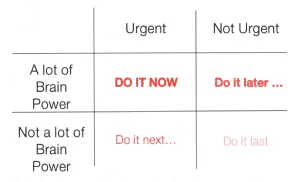Does your to-do list ever seem so impossibly long, you don’t even know where to start? It’s all too easy to find yourself filling your time with menial, insignificant tasks (like reordering your chemistry folder or rearranging your pencil case) to avoid the big scary ones. So how then, when the to-do list is mounting, do we know where to start? The secret lies in prioritisation. Ordering your tasks depending on urgency and difficulty is the best way to ensure you get the things that need doing, done!

So, let me tell you about my trusty friend – the prioritisation square. Here’s how to make one:
- Take a sheet of paper and draw a 2×2 grid on it
- Every time you get a new task, whether that’s an essay, an IA deadline or revising for an end of unit test, write it on a post-it note.
- Evaluate each task in terms of urgency and difficulty
- Urgency:
- due tomorrow = urgent
- due in three weeks = not urgent
- Difficulty:
- A long, complex task that requires lots of time and effort (e.g. Math IA) = difficult
- A small, brainless task (e.g. reading a chapter of your English book) = easy
- Urgency:
Start doing the tasks in the top left
Tasks that are urgent and difficult – always start these first. These will likely be the big and important tasks that are the hardest to get started on.
Then, move onto the bottom left…
Once these are complete, get started on the tasks which are urgent, but not so difficult and time consuming. This could be a set of 5 questions from your exercise book due in two days time.
And onto the top right…
After these, get started on the tasks which aren’t due for a while, but you know will take a lot of time and effort. This could be an upcoming first draft of your Extended Essay due in 3 weeks.
And finally…
Once everything else is completed (well done you!), you can do the non-urgent, easier tasks. Perhaps this is an article that your teacher has suggested you read to compliment your revision!

Remember – tasks change priority. Keep an eye on your deadlines and move your tasks from ‘not-urgent’ to ‘urgent’ accordingly. As a rule of thumb, when a task is due within 4 days or so, it should be classified as urgent.
So, with this trusty new tool, I hope you’ll now be able to make a swift plan of action and burn through that to-do list!
Watch Carly explain in more detail how to use the Prioritisation Square below:
Feeling particularly stressed about your upcoming exams? Check out our Spring Revision Courses – the best way to prepare yourselves to ace your IB finals!
Spring Revision Courses!
AND…
Sign up to a course for £395 or more before Sunday 4th Feb and get a FREE MALAYA WATCH with the code FREEWATCH at checkout!




